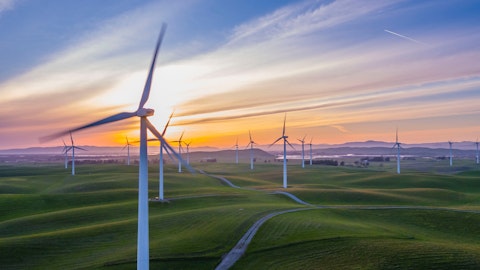Michael Scialla: Yes. Okay. And on the Novo acquisition, if it does close here in the next couple of weeks, do you have a sense of what you’re going to do there in terms of the early development. And I know that you had highlighted when you did the acquisition, that Ovation pad — is that going to be kind of a model where you expect to get to with a lot of their acreage. I just want to see how the plan of attack is for the new acreage you’re getting?
Robert Anderson: Yes. I mean you heard Steve, the Novo rig that they got running right now will end — will complete its pad here, finish drilling its pad here sometime later this month, and we’ll move a rig over there so this done drilling a pad and after closing that it’s working on a pad in the Midland Basin. And we’ll develop it the same, but maybe not 22 wells or something all at one time. We’ll probably take smaller bite sizes there and develop anywhere from four to seven or eight wells at a time. It’s still a little bit of a work in progress. And this is a little bit of an art where you’ve got to take a Rubik’s cube and figure out which colors you want to match up and all that. And we’re working through that right now. But it probably won’t be as big as that 22-well project all at once. But larger project sizes are to come on the Novo project.
Michael Scialla: Great. Thank you.
Operator: Thank you. Our next questions come from the line of Noel Parks with Tuohy Brothers. Please proceed with your questions.
Noel Parks: Hi, good afternoon
Robert Anderson: Hey, Noel.
Noel Parks: Just had a couple. One thing, it’s encouraging to hear how you’re making progress on costs and that the vendor costs and so forth have shown some – given your – because it’s really very by base as we’ve been listening to companies during the turning season. So I’m just curious, do you sort of think this is going to be a normal sort of ebb in the sales side — I’m sorry, in the service cycle this time around. And the thing I was sort of wondering about is a lot of the tightness kind of did stem as effective COVID. But also looking forward, with associated gas in the Permian sort of being a bit of a wild card, depending on how oil is doing, just that there is transfer infrastructure challenges heading forward that might serve the store activity a bit. So, just any thoughts here on that would be great.
Robert Anderson: Well, I mean, there is always an ebb and flow, and there always seems to be a delay in cost coming down when prices have come down. And now we’re back up a few bucks and — so do we see some potential for costs just not coming down as fast. I think a little bit of it is supply and demand. There’s rigs that are leaving gassy basins in Haynesville is a good example and coming to the Permian. And so where operators can tell high-grade rigs, but — and maybe it’s at even a little cheaper price than lower quality or poor performing rigs or something like that. So I think it’s going to take some time. The pressure pumping is probably the biggest number that we’re all working really hard on. And if we can get some relief there, I think we’ll feel really good going into 2024.
Noel Parks: Great. And as your efforts in the northern Midland kind of intensified, just curious, what’s the electrical infrastructure situation look like up there? Is it adequate? Is it stressed?
Robert Anderson: Yeah. I think you’re probably talking about the Northern Delaware, right? Not the Northern Midland?
Noel Parks: Sorry, yes, Northern Delaware. Sorry.
Robert Anderson: Yeah. And the good news is there is infrastructure there. It’s not like we’re in no man’s land. And also the good news is we have the ability, based on our portfolio to change our activity and move things around. So when it does get backed up and it does from time-to-time, either on gas or water, we can see that. And we have the ability to move our plan around a little bit. And we’re planning accordingly. So there is some infrastructure. We’re spending some dollars. We’ve talked about it now for six or seven months that some of our capital plan this year is infrastructure. We got pretty aggressive in the timing of getting a lot of things done in the first half of the year. It’s slipping a little bit to the third quarter, but that’s okay.
We’re still ahead of where we need to be in terms of bringing new wells on and not having any infrastructure. So it’s getting better as we spend money up there ourselves and other operators in the midstream guys continue to see the benefit of adding capacity.
Steve Collins: Specifically on the electric side, with Titus and Chisholm, we’ve released almost 50 generators since we took over. So the electricity is coming. And we’re making that happen and that helps the LOE also quite a bit. It’s always there when you start, but we get it there.
Noel Parks: Great. Thanks a lot.
Clay Jeansonne: Operator, it’s the end of the day for a lot of folks. And we are backed up here because we have a business that we’re going to run. So we appreciate all the calls and all the questions. And we look forward to visiting with you next quarter.
Operator: Thank you. That does conclude today’s teleconference. We appreciate your participation. You may disconnect your lines at this time. Enjoy the rest of the day.
Follow Earthstone Energy Inc (NYSE:ESTE)
Follow Earthstone Energy Inc (NYSE:ESTE)
Receive real-time insider trading and news alerts



